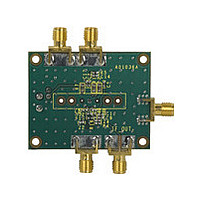AD8342-EVAL Analog Devices Inc, AD8342-EVAL Datasheet - Page 16

AD8342-EVAL
Manufacturer Part Number
AD8342-EVAL
Description
Manufacturer
Analog Devices Inc
Datasheet
1.AD8342-EVAL.pdf
(24 pages)
Specifications of AD8342-EVAL
Lead Free Status / Rohs Status
Not Compliant
AD8342
IF PORT
The IF port comprises open-collector differential outputs. The
NPN open collectors can be modeled as current sources that are
shunted with resistances of ~10 kΩ in parallel with capacitances
of ~1 pF.
The specified performance numbers for the AD8342 were
measured with 100 Ω differential terminations. However,
different load impedances can be used where circumstances
dictate. In general, lower load impedances result in lower
conversion gain and lower output P1dB. Higher load imped-
ances result in higher conversion gain for small signals, but
lower IP3 values for both input and output.
If the IF signal is to be delivered to a remote load, more than a
few millimeters away at high output frequencies, avoid
unintended parasitic effects due to the intervening PCB traces.
One approach is to use an impedance transforming network or
transformer located close to the AD8342. If very wideband
output is desired, a nearby buffer amplifier may be a better
choice, especially if IF response to dc is required. An example of
such a circuit is presented in Figure 45, in which the
differential amplifier is used to drive a pair of 75 Ω transmission
lines. The gain of the buffer can be independently set by
appropriate choice of the value for the gain resistor, R
AD8342
Figure 45. AD8351 Used as Transmission Line Driver and Impedance Buffer
COMM
COMM
IFOM
IFOP
50
45
40
35
30
25
20
15
10
5
0
0
8
7
6
5
100M 200M 300M 400M 500M 600M 700M 800M 900M
100Ω
Figure 44. IF Port Impedance
FREQUENCY (Hz)
R
G
+
–
AD8351
Tx LINE Z
Tx LINE Z
O
O
AD8351
G
= 75Ω
= 75Ω
.
1G
0.5
0.4
0.3
0.2
0.1
0
–0.1
–0.2
Rev. A | Page 16 of 24
Z
L
The high input impedance of the AD8351 allows for a shunt
differential termination to provide the desired 100 Ω load to the
AD8342 IF output port.
It is necessary to bias the open-collector outputs using one of
the schemes presented in Figure 47 and Figure 48. Figure 47
illustrates the application of a center-tapped impedance
transformer. The turns ratio of the transformer should be
selected to provide the desired impedance transformation. In
the case of a 50 Ω load impedance, a 2-to-1 impedance ratio
transformer should be used to transform the 50 Ω load into a
100 Ω differential load at the IF output pins. Figure 48
illustrates a differential IF interface where pull-up choke
inductors are used to bias the open-collector outputs. The
shunting impedance of the choke inductors used to couple dc
current into the mixer core should be large enough at the IF
operating frequency so it does not load down the output current
before reaching the intended load. Additionally, the dc current
handling capability of the selected choke inductors needs to be
at least 45 mA. The self-resonant frequency of the selected
choke should be higher than the intended IF frequency. A
variety of suitable choke inductors is commercially available
from manufacturers such as Murata and Coilcraft®. Figure 46
shows the loading effects when using nonideal inductors. An
impedance transforming network may be required to transform
the final load impedance to 100 Ω at the IF outputs. There are
several good reference books that explain general impedance
matching procedures, including:
•
•
•
180
150
210
Figure 46. IF Port Loading Effects Due to Finite Q Pull-Up Inductors
Chris Bowick, RF Circuit Design, Newnes, Reprint Edition,
1997.
David M. Pozar, Microwave Engineering, Wiley,
3rd Edition, 2004.
Guillermo Gonzalez, Microwave Transistor Amplifiers:
Analysis and Design, Prentice Hall, Second Edition, 1996.
120
240
(Murata BLM18HD601SN1D Chokes)
90
270
500MHz
500MHz
60
300
50MHz
30
330
0
50MHz
REAL
CHOKES
IDEAL
CHOKES










